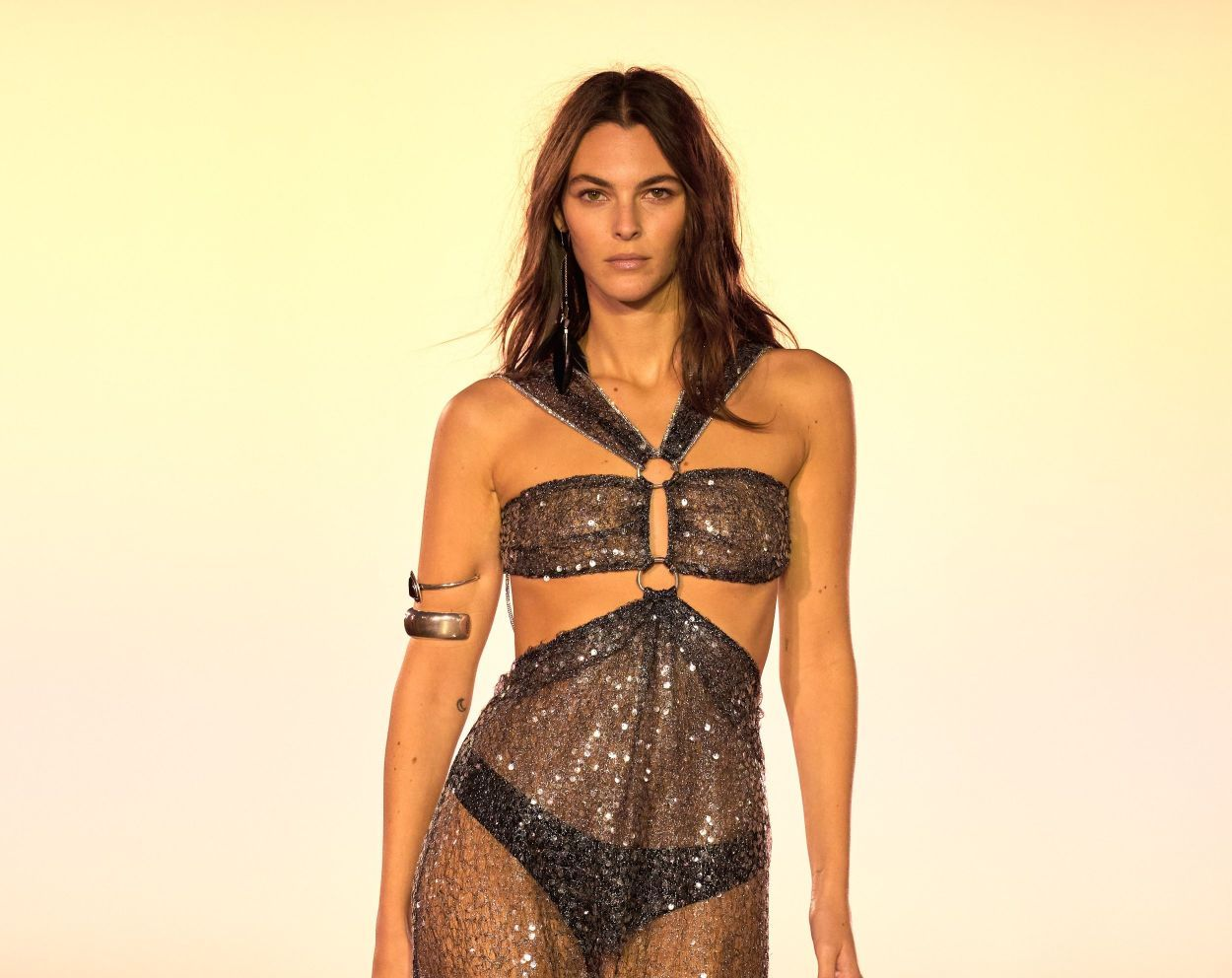London Fashion Week SS20: the #legend guide
Sep 25, 2019
Political but satirical, London Fashion Week was almost an antithesis to the optimism we saw at New York Fashion Week. As we go through what feels like a never-ending break-up with the EU, our fashion favourites sought comfort in the familiar by opening the annals of the past through repurposed archived statements: the mini-dresses of the ’60s; fringe, fringe, fringe; and billowing sleeves. Unlike in New York, London was in search of a more covered approach, whose sleight of hand preferred to graze the fingertips and floor.
Awake Mode
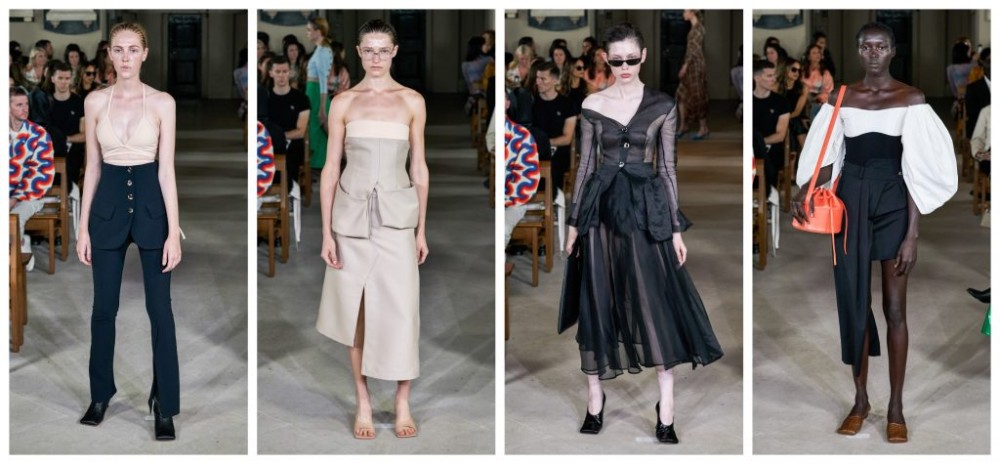
Flirting between propriety and subversion, Natalia Alaverdian’s “singular intention of this label continues to be removal of barriers” through a subtle structural realism that demonstrates her technique so triumphantly. Skirts appeared as trousers and trousers appeared as skirts, playing right into the seditious tendencies of her collection. Not all her subversions were so obvious, as emphasised through her tonal tempering of beige skin-tight dresses, raw-edged silk and rippling midi-skirts. Bustiers constructed from the bottom half of blazers were, quite frankly, a stroke of genius – the very epitome of visionary repurposing. The tailoring, as always, was flawless; each seam seemed carefully thought-out. Edginess and the sultry surfaced in contrast draping, silkiness and an organza ensemble. The teasing of the ankle-grazing sheerness conspired to seduce and hypnotise without stealing the spotlight. The drum-sized bucket bags in their simplicity were the perfect accessory to make a statement while remaining sharp and astute. A contrast to the previous Elizabethan and heroine-inspired collection, Alaverdian proves once again that she has perfected the art of tailoring to a tee.
Burberry
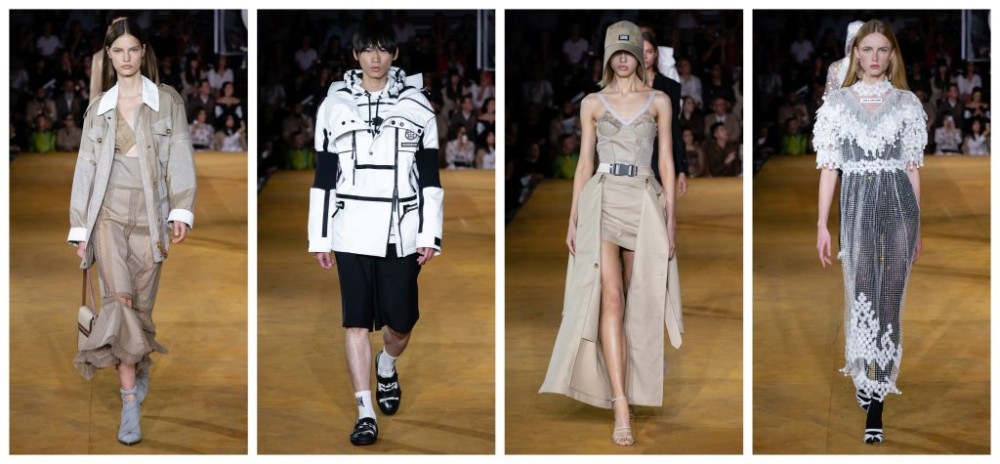
Through Riccardo Tisci’s Italian lens, we were brought a new Victorian era, striking a balance between the sumptuous and the street through a revisiting of Thomas Burberry’s designs from the 1850s. A continuation of the previous season, Tisci brought us the mature older sibling of our eclectic punk, hip-hop-inspired autumn/winter 2019: a cool Britannia with an injection of Italian mystique. We were not deprived of the edge for which we so yearn; with a distinct division between the bourgeois of the businesspeople, we were still afforded the rebellion of the youth in the second part. Tisci graced us with the oversized rugby shirts and even a pair of baggy shorts that marked his past at Givenchy. Joining his contemporaries at Dior and Louis Vuitton, Tisci is moving Burberry towards a more embellished masculinity. While the tones were less vivid, the silvers, camels and monochromes didn’t fail to interest. Tisci’s affinity for sophisticated sultriness was mirrored in the layers of sheer airiness that brushed past guests, with the fanciful fringing and the sharp suiting. Proving the demure doesn’t have to be jejune, garments were decorated with crystals, crystal chainmail and lace. The coveted corsetry of last season continued with a new musing of a more classic nature, as was paralleled in the botanic wallpaper prints we so much enjoyed. Gone was the nova check, signalling a new epoch in Burberry’s story. Although undeniably British, Burberry’s revitalisation has been heralded by Tisci’s Italian vision – a paradoxical turn of events, which is most graciously accepted.
Christopher Kane
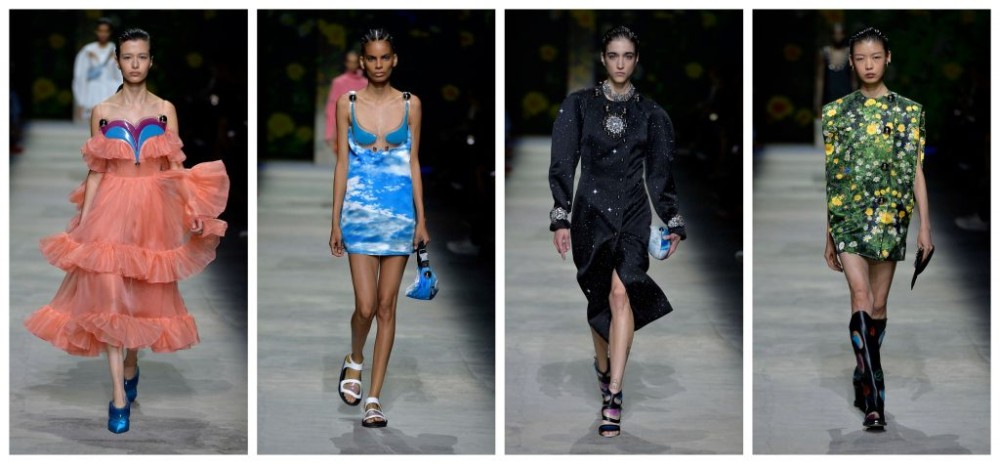
Coining the term “ecosexual” to describe the people who “love the planet, who love to make love to the planet”, Christopher Kane showed us his elucidation of modern erotica. During a time when the Amazon is burning and environmental activism is at its peak, it’s surprising that Kane ironically insisted that this was not a political statement about the climate discussion. There may be a perverse element of humour there, but he is no careless designer. Reinterpreting the sci-fi motifs previously explored, we were counterintuitively given a blast from the past that came from the future. Offerings of earthy garden prints offset the futurism of the door-knob studs, cupcake silhouettes and armour-like cut-out breastplate detailing. Adopting a ’60s undertone with its mini-dresses (straight out of an unseen Austin Powers film) and boisterous prints, these were no ordinary florals for spring. The sexuality that was channelled, unlike the other showings this season, was of a more fun sort, with a little sardonicism thrown in for good measure – you can’t tell us those blue skies aren’t just a little ominous, can you? The Scottish designer brought us an unsuspecting and playful collection fit for the year ahead – eco, it seems, is the new sexy.
Emilia Wickstead
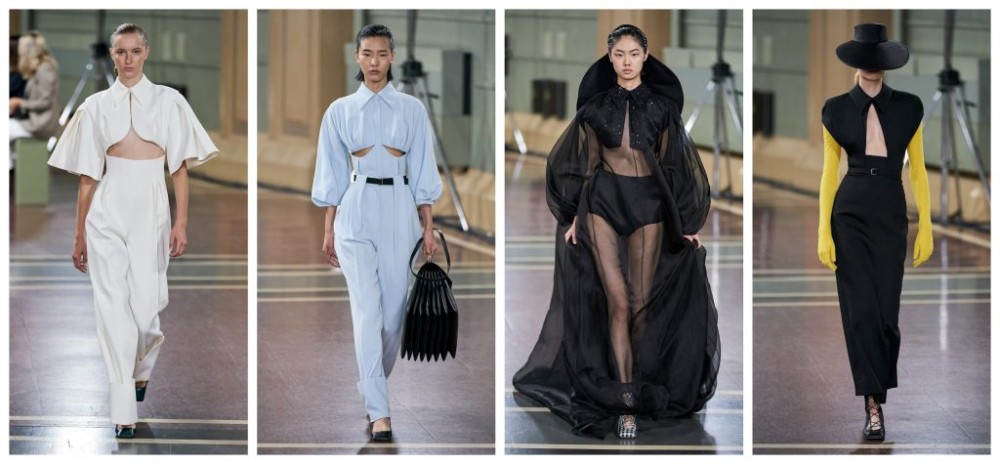
Elegance underlies everything this eponymous designer does; prim and proper, but never stuffy, the collection was tantamount to grace and refinement, and possibly the most put-together showing this season. A rainbow of pastel-hued prairie dresses was exhibited, fit with balloon sleeves, gloves and strategic cut-outs. Redefining power-dressing, Wickstead brought us a new heroine. She’s poised, but still revolutionary with her sartorial prowess and undeniable chic. The low-brimmed hats brought an element of secrecy – our heroine doesn’t need to be known, just noticed. We imagine that the tenacity and fierceness of Jo March would only be able to be encapsulated by the opening white jumpsuit with the flutter sleeves and open midriff – she’s a tomboy, but her femininity is highlighted through her strong will. The show was sandwiched with two sheer black organza pieces, so our heroine isn’t as sweet as her candy-coloured exterior may suggest in the previous looks. Flourishes of gingham sashayed past with pillowing sleeves and contrast trimmings of floral sequin scatterings. The finale look was the literal manifestation of a pink marshmallow – sweet, but not sickly and without a doubt, magical. Our heroine this season has a sweet exterior, but she’s far more complicated than meets the eye. Refashioning convention and remodelling our ideas of the genteel, our classic lady dressing had its limits tested, because as Laurie Laurence said, “Why mind the fashion?”
Huishan Zhang
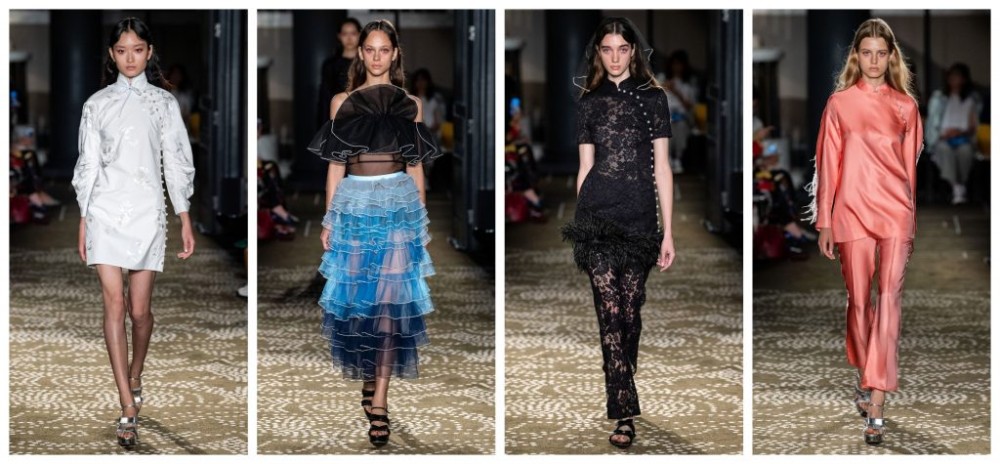
The tired cliché of “East meets West” truly can only be done justice by Huishan Zhang, who proves that his capabilities have no end. Inspired by the “infectious appeal” of the ’60s, we were presented with a different side of this decade – think less Twiggy in retro mini-dresses and more Mrs Chan from In the Mood for Love. Known for his more outlandish and borderline debutante looks, Zhang looked to his home country (and home market) for a little more finesse, as he is quickly becoming the go-to for the upper echelons of Chinese society. The flamboyancy of his chosen decade was reflected in the use of plumage and vivid colourways of salmon pink and electric blue. Opening with a pristine over-the-knee shift cheongsam, he echoed his first V&A collection piece from 2012. Traditional frogging finished with pearls, floral jacquards and delineations of marabou fringe (a staple in this Chinese designer’s repertoire) brushed past on silky pyjama sets and lacey two-pieces. As Zhang never disappoints, extravagance and drama weren’t spared as airy, effortless layers of ruffles paraded past guests. A self-claimed romantic, it was only fitting that models had veils to parallel the romanticism and the emotion of this collection. “Cheongsam will always be guiding my strong and confident women through time, as it did in the movies,” he says, but it seems Zhang himself is guiding our female protagonist.
JW Anderson
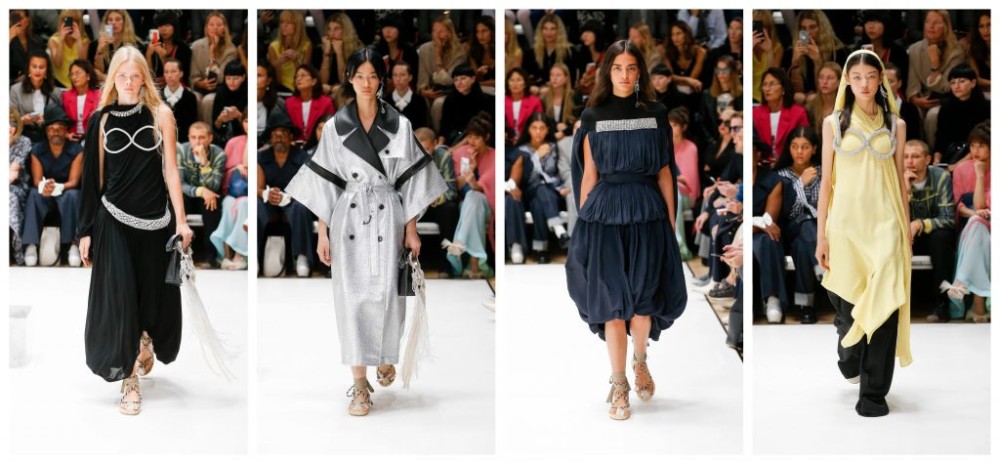
“It’s about looking and questioning… the ability in fashion of being able to refocus.” The venue featured Liz Magor’s Pet Co (2018), composed of transparent plastic boxes encasing colourful childhood toys. Ephemera was the idea that the collection orbited around – items once cherished, maybe lost or maybe found, are repurposed and given new meaning, much like fashion is reworked to suit new audiences, new generations and new narratives. Techniques are altered to give way to new shapes and silhouettes, each conveying a different feeling. Jewellery was one of the central focuses of the collection, recycled and regenerated into glittering breast harnesses, marking a new form of underwear made to be seen – an armour for the more sensual. The opening tunics were almost medieval in their simplicity, with the followings of chainmail-esque metallic shades. The capes, hoods and draping adorned with chunky rhinestone necklaces and belts brought a new meaning to authority – a retelling of a more contemporary Joan of Arc, if you will. This collection marked the maturity of Anderson’s sophistication and documents his journey from a somewhat avant-garde creativity to a more balanced eccentricity. Anderson may have delivered a show that was only 20 minutes long, but the feeling that it evoked was most definitely more transcendent than transient.
Molly Goddard
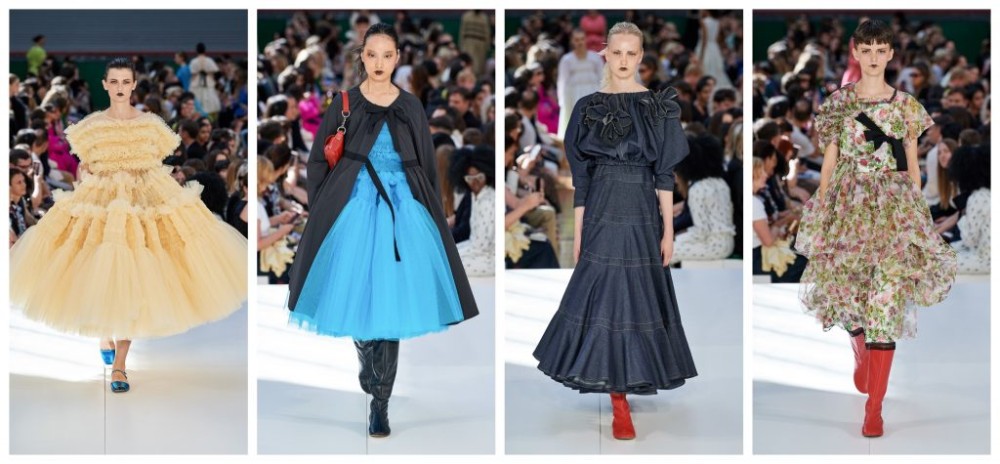
Molly Goddard’s heroine is more Villanelle than damsel in distress this season. With her design immortalised by Killing Eve, it’s difficult to avoid or deny her influence on the high street this past season. The voluminous yet effortlessly airy tulle gowns billowed and breezed down the runway, literally filling it as they brushed past front-row audience members’ knees. Her streamlined wisdom was served in slimmer styles and garnished with trimmings of denim and taffeta skirts. Although ambitious in volume, none were sur le dessus. Unlike her peers who chose themes and modernised the past, Goddard’s individuality and genius shone through her honing of her technical know-how. She aimed to inflate her iconic silhouettes to a larger magnitude without the overcomplications that underpinned them (and we don’t mean this figuratively). Reigning supreme were the propagations of tulle and pouf skirts – if you closed your eyes and heard the rustle alone, you could probably tell it was Molly Goddard. The floral prints added an element of whimsy and jocularity; however, none were more whimsical or jocular than the loofah-like lemonade dream of a gown. A celebration of talent, Molly Goddard’s SS20 collection made clear that she’s only just started.
Ports 1961
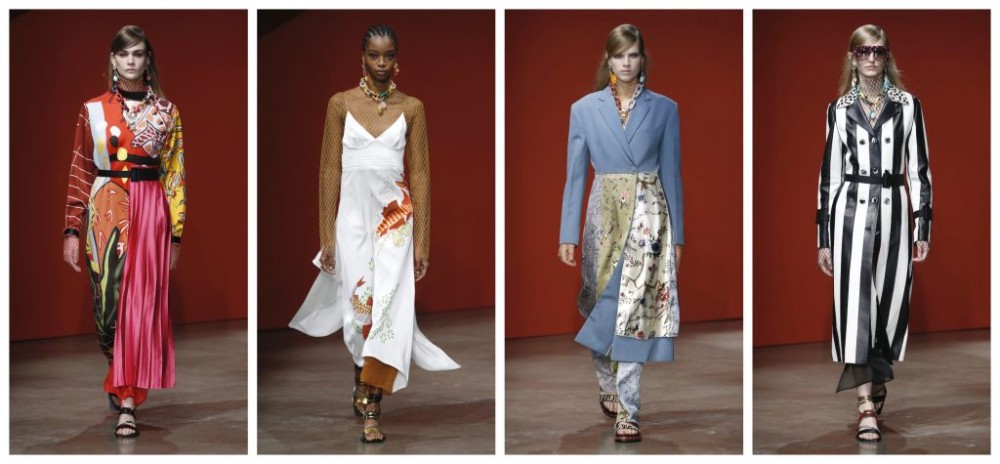
Electric and eclectic, Karl Templer injected a symphony of colour and energy this season: think animal and Hawaiian prints, and a new meaning for the word maximalist. Finding comfort in the familiar, Ports 1961 started with shirt dressing, beginning with a silk maxi-dress amalgamated from a mismatch of Matisse-influenced prints, and finished with a pleated half-skirt. This look would soon become a signature within this collection, along with the unexpected pattern play. We, too, seek relief in the wonted, but we hope to be forgiven for having a bout of déjà vu as we reminisce about last season’s Marni collection. The hybrid pieces were arguably the most memorable; the powder blue single-fastening coat layered under a scarf-like silk was the embodiment of spring and warmer days. Ports 1961 isn’t famed for its accessories; however, it seems that Templer intends to change that as colourful chain necklaces, speckled oversized sunglasses and low-heeled sandals exuded consumer appeal. Befitting of the venue, Tate Modern, Ports 1961 exhibited a collection that was loud without compromising on taste.
Simone Rocha
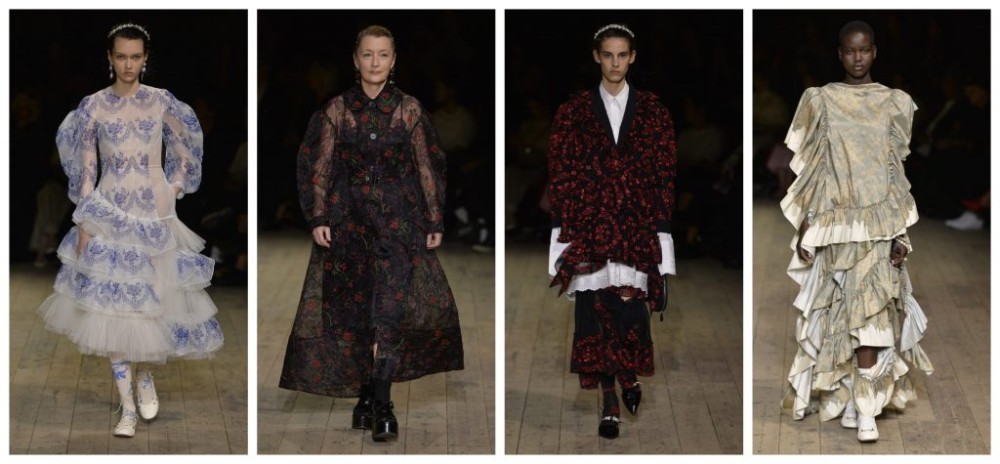
Simone Rocha found solace in her referential collection stemming from the “Wren Boys” of her homeland, Ireland. “Punkish boys who go knocking on doors… so I wanted to bring a masculinity to the table” – and she quite literally meant table, as she derived inspiration from the tablecloths, china and wallpaper of the homes on whose doors were being knocked. We may not be particularly well-versed in the history of folklore or the Celts, but we know how to appreciate art – and art this was. An enchantingly mesmerising collection of delicate ruffles of cobalt and white opened the show – idyllic scenes of countryside tea parties with starched tablecloths, grandma doilies and windows frosted with netting were materialised. We transitioned into a sweet sugar almond-pink set, before taking a darker turn into the more punk-like manifestation of the Wren Boys. Our fairy-tale rurality is disturbed by a harsher, possibly more macabre undertone with the introduction of black ruffles and red sequins – we were bewitched. The pre-Christian tradition was further appreciated through the straw-trimmed outfits, much akin to the ones worn to capture a wren. No details were overlooked in this meticulous medley, with wrens painted on the foreheads of models and ballooning silhouettes mimicking “the outline of the bird”. With such an appreciation for cultural importance, intertwined with the power of women, Simone Rocha captivated us.
Victoria Beckham
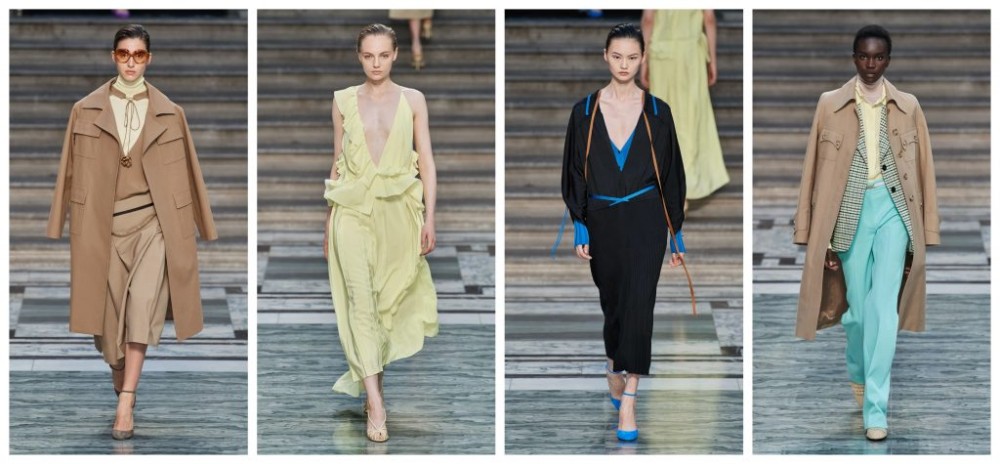
This London Fashion Week favoured freedom, and the more volume, the better. Victoria Beckham continued this trend seamlessly with a sensual practicality: an unrestricted comfort without compromise on fabric. New York Fashion Week brought us a lot of a skin, where nudity was elevated and championed, but not across the pond. The fabric fell flatteringly around the body, and those with the eye for the excellence that is the Beckham matriarch will be rewarded with a sought-after favourite: the pocket. “It just changes your attitude with your hands in your pockets” – and we can guarantee that it makes us far happier customers. Basing its collections on what Beckham wants to wear in addition to what customers want, this season was a delivery of mass appeal. The hallmark sweeping coats were shown alongside flowing pleated dresses, plunging necklines, subtle ruffles and elongated sleeves, gently grazing the fingertips. The looser and freer configuration lengthened each hem a few inches, adding the flavour of the ’70s to this classic refinement. As she describes it herself, “The silhouettes aren’t complicated.” But you needn’t complicate anything when you have a collection as chic and fluid as this.





























